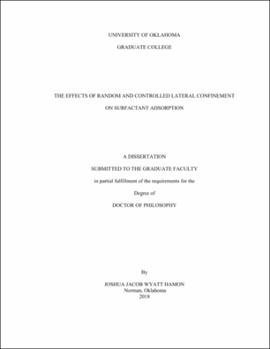| dc.description.abstract | Abstract
The effects of temperature and surface roughness on the mass and viscoelasticity of an adsorbed surfactant layer were monitored using the quartz crystal microbalance with dissipation (QCM-D). Adsorption isotherms at 30, 40, 50 and 60C and at two different roughnesses on gold were measured for cetyltrimethylammonium bromide (CTAB). All isotherms displayed an increase in mass and dissipation as surfactant concentration was increased to its critical micelle concentration (CMC). Above the CMC adsorption reached a peak followed by a slight decrease to a plateau at the equilibrium adsorption value. As the temperature was increased the adsorbed mass above the CMC decreased. The adsorbed mass decreased further by increasing substrate roughness, while the dissipation remained statistically unchanged. Dynamic adsorption experiments were also conducted at various temperatures for select concentrations above and below the CMC, providing evidence of different adsorption mechanisms as a function of both surfactant concentration and surface roughness.
Force curves collected using an atomic force microscope (AFM) in the presence of adsorbed surfactants are often used to draw conclusions about adsorbed film packing, rigidity and thickness. Force curves were collected from tetradecyltrimethylammonium bromide (TTAB) films adsorbed on highly ordered pyrolytic graphite (HOPG), silica, and silica that had been hydrophobized by functionalization with dichlorodimethyl silane. Break-through events in the force curves from several different trials were compared to show that the break-through distance, often reported as the adsorbed film thickness, increased with concentration below the critical micelle concentration (CMC) but was approximately 3.5 nm on all surfaces between 2× and 10× CMC; an unexpected result because of the different surface chemistries for the three surfaces. We employed an AFM probe with a different force constant (k) value as well as a colloidal probe and the break-through distance remained approximately 3.5 nm in all cases. Gradient mapping, a variant of force mapping, was also implemented on the three surfaces and resulted in a new technique for visualizing adsorbed surfactant in situ. The resulting maps showed patches of adsorbed surfactant below the CMC and revealed that with increasing concentration, the size of the patches increased resulting in full coverage near and above the CMC. These results are, to our knowledge, the first-time force mapping has been used to spatially track patches of adsorbed surfactant. Finally, layers of surfactants on an AFM tip were investigated by collecting a force map on a single AFM tip using the tip of a separate AFM probe. A break-through event was observed between the tips, indicating a layer of surfactant was present on at least one, if not both tips.
Lastly, AFM force curves and nanoscale trenches and pillars were used to investigate the effects of lateral confinement on two cationic surfactants, TTAB and CPC. These laterally confined surfaces are model surfaces for rough surfaces; these surfaces allow for more controlled studies regarding the effect of surface roughness on adsorption. The trenches, formed in a PMMA layer on silica, were 50 nm and 80 nm. Break-through distances, break-through forces and adhesion forces were calculated from the curves on the polymer and on the silica trench floor. For both surfactants, adsorption on the polymer reduced all break-through values. Compared to unconfined values, TTAB in trenches had decreased break-through forces and adhesion forces but CPC forces were unaffected, indicating that surfactant identity could vary the confinement effect. Trench width had no effect on break-through values.
Lateral confinement induced by pillars was studied by noting changes in break-through event values near to the edge of the upper surfaces of pillars. Values decay or increase according to a single exponential with distance from the edge, with decay constants of 12.90 nm±1.84, 14.5 nm± 0.663, and 17.07 nm± 1.227 for the break-through distance, break-through force and adhesion forces, respectively. The break-through distance was found to decrease over its decay length while the break-through force and adhesion force increased. These trends suggest that surfactant layer becomes extended and less mechanically stable due to having to make the ~90° turn between the upper surface and side of the pillar; the former agrees with molecular dynamic simulations. However, decay lengths are much larger than have been found previously in molecular dynamic simulations and we discuss possible reasons for differences. | en_US |
